
Porsche 962
Encyclopedia
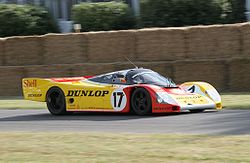
Porsche
Porsche Automobil Holding SE, usually shortened to Porsche SE a Societas Europaea or European Public Company, is a German based holding company with investments in the automotive industry....
as a replacement for the 956
Porsche 956
The Porsche 956 was a Group C sports-prototype racing car designed by Norbert Singer and built by Porsche in 1982 for the FIA World Sportscar Championship...
and designed mainly to comply with IMSA
International Motor Sports Association
The International Motor Sports Association is an American sports car auto racing sanctioning body based in Braselton, Georgia. It was started by John Bishop, a former employee of SCCA , and his wife Peggy in 1969 with help from Bill France, Sr...
's GTP
IMSA GT Championship
IMSA GT was a sports car racing series organized by International Motor Sports Association. Races took place primarily in the United States and occasionally in Canada.-History:...
regulations, although it would later compete in the European Group C
Group C
Group C was a category of motorsport, introduced by the FIA in 1982 for sports car racing, along with Group A for touring cars and Group B for GTs....
formula as the 956 had. The 962 was introduced at the end of 1984, from which it quickly became successful through private owners while having a remarkably long-lived career, with some examples still proving competitive into the mid-1990s.
Development

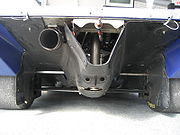
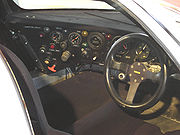
Porsche 956
The Porsche 956 was a Group C sports-prototype racing car designed by Norbert Singer and built by Porsche in 1982 for the FIA World Sportscar Championship...
was developed in late 1981, the intention of Porsche was to run the car in both the World Sportscar Championship
World Sportscar Championship
The World Sportscar Championship was the world series run for sports car racing by the FIA from 1953 to 1992.The championship evolved from a small collection of the most important sportscar, endurance and road racing events in Europe and North America with dozens of gentleman drivers at the grid,...
and the North American IMSA GTP Championship. However IMSA GTP regulations differed from Group C and subsequently the 956 was banned in the US series on safety grounds as the driver's feet were ahead of the front axle center line.
To make the 956 eligible under the IMSA regulations, Porsche extended the 956's wheelbase
Wheelbase
In both road and rail vehicles, the wheelbase is the distance between the centers of the front and rear wheels.- Road :In automobiles, the wheelbase is the horizontal distance between the center of the front wheel and the center of the rear wheel...
to make room for the pedal box. A steel roll cage was also integrated into the new aluminium chassis. For an engine, the Porsche 934
Porsche 934
The Porsche 934 was a racing version of the Porsche 911 Turbo, prepared to FIA Group 4 rules, similar to the Porsche 935 which was prepared to FIA Group 5 rules.-History:...
-derived Type-935 2.8L flat-6 was used with air cooling and a single Kühnle, Kopp und Kausch AG K36 turbocharger instead of the twin K27 turbochargers of the Group C
Group C
Group C was a category of motorsport, introduced by the FIA in 1982 for sports car racing, along with Group A for touring cars and Group B for GTs....
956, as twin-turbo systems were not allowed in IMSA's GTP class at the time.
The newer Andial built 3.2L fuel injected Flat-6 would be placed in the 962 by the middle of 1985 for IMSA GT, which made the car more competitive against Jaguar
Jaguar (car)
Jaguar Cars Ltd, known simply as Jaguar , is a British luxury car manufacturer, headquartered in Whitley, Coventry, England. It is part of the Jaguar Land Rover business, a subsidiary of the Indian company Tata Motors....
. However it would not be until 1986 that the 2.6L unit from the 956 was replaced in the World Sportscar Championship, using 2.8L, 3.0L, and 3.2L variants with dual turbochargers. The cars run under World Sportscar Championship regulations were designated as 962C to separate them from their IMSA GTP counterparts.. The 3.2L unit, which had been eligible under IMSA's Group 3 engine rules was banned in IMSA by 1987 In 1988, to counteract against the factory Nissans and the threat of withdrawal from Porsche teams, watercooled twin turbo Porsche engines would be allowed back but with 36 mm restrictors.
In total, Porsche would produce 91 962s between 1984 and 1991. 16 were officially used by the factory team, while 75 were sold to customers. Some 956s were rebuilt as 962s, with two being previously written off and four others simply rebuilt. Three 962s that were badly damaged were also rebuilt had been given a new chassis number due to the extensive reconstruction. Due to the high demand for 962 parts, some aluminium chassis were built by Fabcar in the United States before being shipped to Germany for completion. Derek Bell, a 5-time Le Mans winner, drove the 962 to 21 victories between 1984 and 1987, remarked that it was "a fabulous car, but considering how thorough (Norbert) Singer
Norbert Singer
Norbert Singer is a German automotive engineer. He has played a key role in every one of Porsche’s 16 overall race victories at the 24 Hours of Le Mans.Singer was born in Eger , part of Nazi Germany's Sudetenland in 1939....
(the designer of the 962 and head of Porsche's motorsport division at the time) and the team were, it was really quite easy to drive."
Modifications
Due to the sheer numbers of 962s, some teams took it upon themselves to adapt the car to better suit their needs or to remain competitive. These modifications included new bodywork for better aerodynamic efficiency, while others changed mechanical elements. Long-time Porsche campaigner Joest RacingJoest Racing
Joest Racing is a racing team that was established in 1978 by former Porsche works racer Reinhold Joest...
heavily modified a pair of 962s for the IMSA GTP Championship in 1993 to better compete against Jaguar
Jaguar (car)
Jaguar Cars Ltd, known simply as Jaguar , is a British luxury car manufacturer, headquartered in Whitley, Coventry, England. It is part of the Jaguar Land Rover business, a subsidiary of the Indian company Tata Motors....
, taking the 962s final sprint race victory (Road America) that season.
Privately-built 962s

Among the most popular privately-built 962s was that from Kremer Racing
Kremer Racing
Kremer Racing is a motorsports team based in Cologne, Germany, founded by racing driver Erwin Kremer and his brother Manfred. They have competed internationally with Porsches for nearly all of their existence, and were even one of the factory-backed squads for many years...
, termed the 962CK6, which did away with the original aluminium sheet tub of the original Porsche chassis, replacing it instead with a carbon fibre tub. 11 total were built, campaigned by Kremer and other teams. John Thompson designed a chassis for Brun Motorsport
Brun Motorsport
Brun Motorsport GmbH was a Swiss auto racing team founded by driver Walter Brun in 1983. They competed as a Porsche privateer team in sports car racing for their entire existence, running in a multitude of international championships. They notably won the World Sportscar Championship in 1986 and...
, eight of which were built and helped the team take second in the World Sportscar Championship in 1987. Thompson would later build two chassis for Obermaier Racing. Richard Lloyd Racing
Richard Lloyd Racing
Richard Lloyd Racing , originally named GTi Engineering, was a British auto racing team created in 1977 by driver Richard Lloyd. Originally named for the Volkswagen Golf GTIs that Lloyd raced in the British Saloon Car Championship , they went on to become a successful Porsche privateer in the...
's GTI Engineering would turn to Peter Stevens and Nigel Stroud to develop four 962C GTis, which featured entirely revised aero and aluminium honeycomb rather than sheet tubs. Former factory Porsche driver Vern Schuppan
Vern Schuppan
Vernon "Vern" Schuppan is a racing driver from Whyalla, South Australia. Schuppan drove in various categories, participating in Formula One, the Indianapolis 500 and most successfully in sports car racing.-Formula One:...
would also build five new chassis, some known as TS962s.
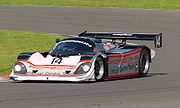
Dyson Racing
Dyson Racing is a professional sports car racing team based in Poughkeepsie, New York in the United States. Founded by Rob Dyson in 1974, the team is one of the longest-running and most successful privateer racing organizations. Over the years, it has competed in IMSA GTO and GTP, SCCA Trans-Am,...
purchased a Richard Lloyd Racing/GTi Engineering 962 monocoque for use in their Porsche 962 DR-1 chassis. A Fabcar tub was used in Dyson's Porsche 962 DR-2.
Some 962s were even more extensively modified, with several open-cockpit versions being developed in the mid-1990s to run under new sportscar regulations. Kevin Jeanette built the Gunnar 966, mimicking elements from the 917/30 Can-Am cars. Meanwhile, Kremer Racing would once again develop their own chassis, with the open-cockpit CK7 running in Interserie
Interserie
Interserie is the name of a European-based motorsport series started in 1970 that allows for a wide variety of racing cars from various eras and series to compete with less limited rules than in other series....
and K8
Kremer K8 Spyder
The Kremer K8 Spyder, along with its predecessor, the CK7, were open-cockpit prototypes built by Kremer Racing for use in multiple sportscar series, such as the IMSA GT Championship, Interserie, and International Sports Racing Series...
running at Le Mans. These cars shared little with the original 962s, using custom bodywork and chassis designs, yet retaining the engine and some suspension elements.
Racing history
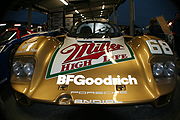
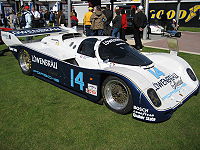
24 Hours of Daytona
The 24 Hours of Daytona, currently known as the Rolex 24 Daytona for sponsorship reasons, is a 24-hour sports car endurance race held annually at Daytona International Speedway in Daytona Beach, Florida. It is run on a combined road course, utilizing portions of the NASCAR tri-oval and an infield...
with Mario
Mario Andretti
Mario Gabriele Andretti is a retired Italian American world champion racing driver, one of the most successful Americans in the history of the sport. He is one of only two drivers to win races in Formula One, IndyCar, World Sportscar Championship and NASCAR...
and Michael Andretti
Michael Andretti
Michael Mario Andretti is a retired American CART and Formula One driver and owner of the Andretti Autosport team in the IndyCar Series. Andretti is the son of Mario Andretti. His son is Marco Andretti.-Early career:...
driving the factory car which led the race until it retired during lap 127 with engine and gearbox problems.
For 1985, the 962C would debut in the World Sportscar Championship, but ironically the car lost to an older 956, which had already taken WEC top-honors four times. Under pressure from new cars from Jaguar
Jaguar (car)
Jaguar Cars Ltd, known simply as Jaguar , is a British luxury car manufacturer, headquartered in Whitley, Coventry, England. It is part of the Jaguar Land Rover business, a subsidiary of the Indian company Tata Motors....
and Mercedes-Benz
Mercedes-Benz
Mercedes-Benz is a German manufacturer of automobiles, buses, coaches, and trucks. Mercedes-Benz is a division of its parent company, Daimler AG...
, in 1987 Porsche again brought in a new engine, a more durable and powerful 3.0 L unit which powered the car to an overall win at the 1987 24 Hours of Le Mans
1987 24 Hours of Le Mans
The 1987 24 Hours of Le Mans was the 55th Grand Prix of Endurance, and took place on June 13 and 14 1987. It was also the fifth round of the 1987 World Sports-Prototype Championship.-Track alterations:...
, Porsche's record seventh consecutive victory at the race.
After a post-'87 "dry spell", Porsche customer Jochen Dauer
Dauer
Dauer may refer to:* Jochen Dauer, a former German race car driver, leather magnate, and proprietor of Dauer Sportwagen GmbH, notable for converting Porsche 962 race cars for use on the road as Dauer 962 Le Mans...
got the 962 re-classified as a road legal GT1 car under a loophole in the new ACO
Automobile Club de l'Ouest
The Automobile Club de l'Ouest , sometimes abbreviated to ACO, is the largest automotive group in France. It was founded in 1906 by car building and racing enthusiasts, and is most famous for being the organising entity behind the annual Le Mans 24 Hours race...
regulations for the 1994 24 Hours of Le Mans
1994 24 Hours of Le Mans
The 1994 24 Hours of Le Mans was the 62nd Grand Prix of Endurance, and took place on June 19 and 20, 1994.-Race:The 1994 race was won by a car that had its roots in a 10 year old design...
.
Achievements
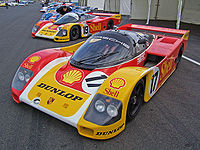
World Sportscar Championship
The World Sportscar Championship was the world series run for sports car racing by the FIA from 1953 to 1992.The championship evolved from a small collection of the most important sportscar, endurance and road racing events in Europe and North America with dozens of gentleman drivers at the grid,...
title in 1985 and 1986, the IMSA GT Championship
IMSA GT Championship
IMSA GT was a sports car racing series organized by International Motor Sports Association. Races took place primarily in the United States and occasionally in Canada.-History:...
every year from 1985 to 1988, the Interserie
Interserie
Interserie is the name of a European-based motorsport series started in 1970 that allows for a wide variety of racing cars from various eras and series to compete with less limited rules than in other series....
championship from 1987 until 1992, all four years of the Supercup
Supercup
The series was initially sponsored by sport auto magazine during its inaugural season, then replaced by Würth the following two years. Television network Sat.1 sponsor the championship's final year.-Format:...
series (1986 to 1989), and the All Japan Sports Prototype Championship
All Japan Sports Prototype Championship
The , abbreviated as JSPC, formed by the Japanese Automobile Federation, was a domestic championship which took place in Japan for Group C and IMSA GTP prototype cars and also featured cars that were eligible for touring car racing in its earlier years...
from 1985 until 1989. The 962 also won the 24 Hours of Le Mans
24 Hours of Le Mans
The 24 Hours of Le Mans is the world's oldest sports car race in endurance racing, held annually since near the town of Le Mans, France. Commonly known as the Grand Prix of Endurance and Efficiency, race teams have to balance speed against the cars' ability to run for 24 hours without sustaining...
in 1986 and 1987 as well as later winning under the Dauer 962 badge in 1994.
The presence of strong factory teams, such as Jaguar
Jaguar (car)
Jaguar Cars Ltd, known simply as Jaguar , is a British luxury car manufacturer, headquartered in Whitley, Coventry, England. It is part of the Jaguar Land Rover business, a subsidiary of the Indian company Tata Motors....
, Mercedes-Benz
Mercedes-Benz
Mercedes-Benz is a German manufacturer of automobiles, buses, coaches, and trucks. Mercedes-Benz is a division of its parent company, Daimler AG...
, Nissan, and Toyota, competing against privateer 962s eventually led to the car becoming less successful in the later 1980s. Even though they struggled, 962s would continue to win races into 1993, taking lone victories in the IMSA GT and Interserie seasons. Although Dauer's Le Mans victory in 1994 featured a highly modified car, Team Taisan would take the final victory ever in an original 962C, winning an All Japan Grand Touring Car Championship event at Fuji Speedway
Fuji Speedway
is a race track standing in the foothills of Mount Fuji, in Oyama, Suntō District, Shizuoka Prefecture, Japan. It was built in the early 1960s and hosted the first Formula One race in Japan in 1976. In the 1980s, Fuji Speedway was used for the FIA World Sportscar Championship and national racing...
in August of that year, just over ten years after the car had first debuted.
Road versions
Towards the end of the car's competition life, a number of privateer teams and tuners began converting 962s for road use. The concept was that the 962, which had performed so well on the track, would be ideally suited as a supercar for the road. An almost standard car was registered (BB-PW 962) and briefly driven on the road for a German magazine, although the original headlight height and underbody configuration rendered the car illegal under German regulations.The first company outside Porsche to modify a 962 into a road car was Koenig, a German tuner who had previously raced 962s. Known as the C62, the car was completed in 1991 and featured entirely new bodywork in order to better adapt to German regulations. The engine was expanded to 3.4L and saw the addition of a newer Motronic
Motronic
Motronic is the trade name given to a range of digital engine-management systems developed by Robert Bosch GmbH, commonly known as Bosch.-Motronic ML1.x:Motronic ML1.x was one of the first digital engine-management systems developed by Bosch...
system. It is unknown how many were built by Koenig.
German tuner DP Motorsports completed a road conversion in 1992, with a total of three cars, known as DP62, built upon existing 962 racing chassis. Modifications included moving the headlights higher to meet German legal requirements, plus the addition of a 3.3 L twin-turbo Flat-6.
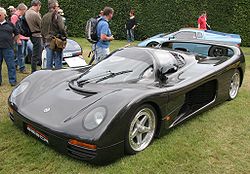
Vern Schuppan
Vernon "Vern" Schuppan is a racing driver from Whyalla, South Australia. Schuppan drove in various categories, participating in Formula One, the Indianapolis 500 and most successfully in sports car racing.-Formula One:...
created his Schuppan 962CR
Schuppan 962CR
The Schuppan 962CR was a vehicle built in 1994 by Australian racecar driver Vern Schuppan. It was built as a tribute to Schuppan's 1983 24 Hours of Le Mans victory and 1989 All Japan Sports Prototype Championship title...
for Japanese customers, with a list price of 195 million Yen, or UK£830,000. The bodywork and chassis were completely new and unique, designed by Mike Simcoe of GM Holden in Australia, but the engine was taken directly from 962s, although it was also expanded to 3.3 litres. An unknown number were built before funding failed to materialize. Before the run of CRs, however, at least two 962R (or LM) cars were built. The first, UK-registered H726 LDP, was little-modified from its race days. 962/123 raced at Le Mans in 1988 and was in Schuppan's workshop when the decision was made to convert it to road use. A decal on the nose read "962R Le Mans Prototype", although the car is often referred to as a 962LM. It differed from many of the street versions in having a British-built aluminium honeycomb chassis. The 962R featured in a number of UK and Australian magazines in summer 1991.
Jochen Dauer Dauer 962 Le Mans
Dauer 962 Le Mans
The Dauer 962 Le Mans is a sports car based on the Porsche 962 racing car. Built by German Jochen Dauer's Dauer Racing, a racing version of this car went on to win the 1994 24 Hours of Le Mans with the support of Porsche through the use of regulation loopholes.- Road car :Dauer Racing produced...
, used original racing chassis for his GT1 versions of the 962, both road and race. The bodywork was all new, yet retained many elements from the original 962s. However, unlike the previous road cars, Dauer took the 962 Le Mans racing once again. With the assistance of Porsche
Porsche
Porsche Automobil Holding SE, usually shortened to Porsche SE a Societas Europaea or European Public Company, is a German based holding company with investments in the automotive industry....
and using a loophole in the rules for the 24 Hours of Le Mans
24 Hours of Le Mans
The 24 Hours of Le Mans is the world's oldest sports car race in endurance racing, held annually since near the town of Le Mans, France. Commonly known as the Grand Prix of Endurance and Efficiency, race teams have to balance speed against the cars' ability to run for 24 hours without sustaining...
, Dauer was successfully able to race his modified 962s and win the race overall.
A run of Derek Bell edition 962 road cars was planned, but only one completed, powered by a 550 bhp engine from the 993 GT2. It was on sale, complete with the rights to continue the run, in 2007.
External links
- Porsche USA - 1984 Porsche 962
- 962.com - History of the Porsche 956 and 962
- World Sports Racing Prototypes - Porsche 962 chassis index
- Mulsanne's Corner - Dyson Racing's modified 962 DR2
- Mulsanne's Corner - Joest Racing's modified 962

